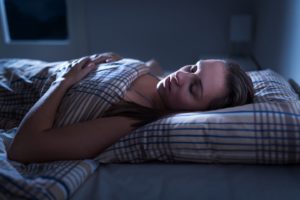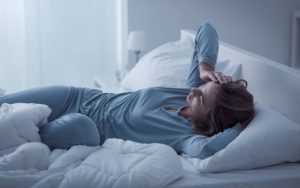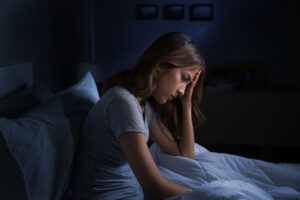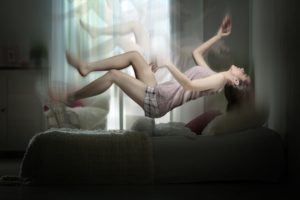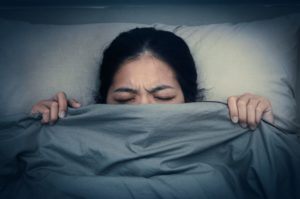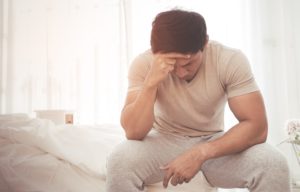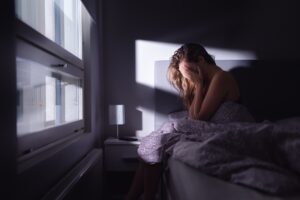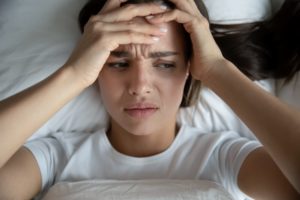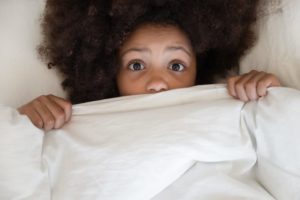Sleepwalking: What Is Somnambulism?
- Sleepwalking is a sleep disorder involving walking or other behaviors during sleep.
- Sleepwalking can affect both children and adults, but is more common during childhood.
- Factors like genetics, sleep deprivation, medications, and stress may trigger sleepwalking episodes.
- Eliminate safety risks, lock doors, and talk to your doctor about any concerns about sleepwalking.
Sleepwalking, formally known as somnambulism, is a behavior disorder that originates during deep sleep and results in walking or performing other complex behaviors while still mostly asleep. It is more common in children than adults and is more likely to occur if a person has a family history of the condition, is sleep deprived, or is prone to repeated nighttime awakenings.
Accidents during these episodes can cause injuries, and sleepwalking is associated with worse sleep and daytime drowsiness. Active treatment may not be necessary for many people, but when episodes are more frequent or intense, several treatment options may be beneficial.
Is Your Troubled Sleep a Health Risk?
A variety of issues can cause problems sleeping. Answer three questions to understand if it’s a concern you should worry about.
Is Sleepwalking a Sleep Disorder?
Sleepwalking is a type of sleep disorder known as a parasomnia. Parasomnias are abnormal behavior during sleep. In fact, parasomnias straddle a border between sleep and wakefulness , which is why the actions that occur during parasomnia episodes are abnormal.
Parasomnias can be categorized based on the part of the sleep cycle during which they occur. Sleepwalking happens during non-REM (NREM) sleep, usually in stage 3 of the sleep cycle, which is also known as deep sleep. Along with other parasomnias like sleep talking, confusional arousals, and sleep terrors, sleepwalking is classified as an NREM disorder of arousal.
What Are the Symptoms of Sleepwalking?
It is important to recognize that, despite the name, sleepwalking is not limited to walking . Episodes of sleepwalking can involve various simple or complex actions and can last anywhere between a few seconds to a half an hour, when the person either wakes up confused or returns to bed on their own. Less often, behaviors can be violent or may be more complex, including trying to drive a car. An episode may involve:
- Walking or running
- Open, glassy eyes with a blank look on their face
- Minimally responsive or incoherent speech
- Routine actions, like getting dressed or moving furniture
- Engaging in sexual behavior (sexsomnia)
- Urinating in inappropriate places
A key symptom of sleepwalking and other NREM parasomnias is that the person virtually never has a recollection of the episode when they wake up. For that reason, they most often learn about their sleepwalking from a family member or housemate. Another common element of NREM parasomnias is that they typically occur during the first half of the night when a person tends to spend a higher percentage of time in deep NREM sleep stages.
How Common Is Sleepwalking?
The fact that people who sleepwalk don’t remember episodes makes it challenging to precisely determine how often it occurs. In addition, studies sometimes define sleepwalking in different ways.
Attempting to account for these methodological difficulties, a meta-analysis considered 51 separate studies of sleepwalking and concluded that 5% of children and 1.5% of adults experienced an episode in the last 12 months.
What Are the Dangers of Sleepwalking?
There can be serious health consequences from sleepwalking. Injury can occur if a person trips and falls or collides with something while walking or running. Mishandling of sharp objects or trying to drive a car during an episode can be life-threatening. Violent behavior can cause harm to the sleepwalker or others.
Actions during sleepwalking episodes may bring embarrassment. For example, a person may feel ashamed about sexually explicit behavior, aggressive outbursts, or urinating in the wrong place.
Studies have found that people who sleepwalk have higher levels of excessive daytime sleepiness and insomnia symptoms. It is not known if these problems arise because of actual disturbances from sleepwalking or if there is an underlying factor affecting their sleep that makes them at risk for both sleepwalking and daytime drowsiness.
In addition, sleepwalking can have consequences for a bed partner, roommates, and/or housemates. Episodes can cause disruptions to their sleep, and they can be negatively affected by a person’s behavior during episodes.
What Are the Causes of Sleepwalking?
Sleep experts believe that sleepwalking normally happens when a person is in a stage of deep sleep and gets partially awoken in a way that triggers physical activity while remaining mostly asleep. Various factors influence how likely this type of partial awakening is to occur:
- Genetics and family history: Studies shows a clear pattern in which certain people are genetically predisposed to sleepwalking and other NREM parasomnias. About 22% of children whose parents have no history of sleepwalking will experience this condition. In contrast, 47% of children sleepwalk if one parent has a history of it, and 61% of children sleepwalk if both parents do.
- Sleep deprivation: A lack of sleep has been correlated with an elevated risk of sleepwalking, which may be due to more time spent in deep sleep after a period of sleep deprivation.
- Some medications: Medications with a sedative effect may push people into a type of sleep that increases their chances of having a sleepwalking episode.
- Alcohol: Drinking alcohol in the evening can create instability in a person’s sleep stages and may heighten the risk of sleepwalking.
- Brain injury: Conditions that affect the brain, including swelling of the brain ( encephalitis ), may be a trigger for sleepwalking.
- Fever: In children, fever has been found to make sleepwalking more likely, and it may be related to an increased number of illness-driven arousals during the night.
- Obstructive sleep apnea (OSA): OSA is a sleep disorder in which the airway gets blocked, causing short lapses in breath during sleep. These pauses, which can occur dozens of times per night, create sleep interruptions that may give rise to sleepwalking.
- Restless Leg Syndrome (RLS): RLS is a type of sleep disorder that causes a powerful urge to move the limbs, especially the legs, when lying down. It causes nighttime arousals from which a person may enter into a sleepwalking episode.
- Stress: Various types of stress can affect sleep, including causing more fragmented or disrupted sleep that can increase the propensity for sleepwalking . Stress can be physical, such as from pain, or emotional. Some types of stress may be related to discomfort or change such as when traveling and sleeping in an unfamiliar place.
Children who sleepwalk may find that episodes stop occurring as they get older, or they may continue to sleepwalk as adults. Even though most sleepwalking starts in childhood, the condition can begin in adulthood as well.
How Is Sleepwalking Treated?
Treatment for sleepwalking depends on the patient’s age, how frequently it occurs, and how dangerous or disruptive the episodes are. For children and adults, it’s best to raise concerns about sleepwalking with a doctor who can work to find the most likely cause and create a tailored treatment plan.
In many cases, sleepwalking requires no active treatment because episodes are rare and pose little risk to the sleeper or those around them. Episodes often get less frequent with age, so for some people, sleepwalking is resolved on its own with any specific therapy.
When it is necessary to take steps to address sleepwalking, there are a number of approaches that may be incorporated into a treatment plan.
Eliminate Safety Risks
Harm reduction is an important consideration for people who sleepwalk. Some ways that safety risks can be reduced include:
- Keeping sharp objects or weapons locked away and out of reach
- Closing and latching doors and windows
- Removing tripping hazards from the floor
- Installing lights with motion sensors
- If necessary, using door alarms or a bed alarm that goes off if a person gets out of bed
Treat Underlying Causes
If a person’s sleepwalking is tied to an underlying disorder like OSA or RLS, treating that condition may resolve sleepwalking. Similarly, if the use of sedatives or other medications is contributing to sleepwalking, the doctor may recommend changing the dosage or switching to a different drug.
Anticipated Awakening
Anticipatory awakening is waking someone up shortly before a potential sleepwalking episode is likely to occur. Because sleepwalking is connected to a specific sleep stage, it often happens around the same time each night. Waking someone up just before that time can prevent them from having the partial awakening that can provoke sleepwalking.
Anticipated awakening has been effective in helping many children stop sleepwalking. It may be useful for others but has not been carefully studied in adult patients.
Improve Sleep Hygiene
Sleep hygiene refers to a person’s sleep-related environment and habits. Poor sleep hygiene, such as having an inconsistent sleep schedule or drinking caffeine or alcohol close to bedtime can contribute to sleeping problems and sleep deprivation. Additionally it’s important to use the best mattress for your needs, taking into account your sleeping position and body type.
Improving sleep hygiene encourages more stable and dependable sleep while reducing the risk of sleep deprivation that can trigger sleepwalking.
Cognitive Behavioral Therapy
Cognitive behavioral therapy (CBT) is a form of talk therapy that counteracts negative thoughts and actions. CBT for insomnia (CBT-I) has demonstrated effectiveness in improving sleep, often by reframing how a person thinks about sleep. Adaptations of CBT exist for stress and anxiety, and careful application of CBT, including relaxation techniques, may help prevent stress-related episodes of sleepwalking.
Medication
When other treatments are not effective, medications may be considered to try to stop sleepwalking. Examples include benzodiazepines and antidepressants. Early research has indicated that melatonin may be helpful in addressing sleepwalking as well.
Any medication, whether prescription or over-the-counter, has potential benefits and risks, and a doctor is in the best position to determine whether it is appropriate in any person’s specific situation.
Is It Safe to Wake a Person Who Is Sleepwalking?
Most experts advise against jarring awakenings for people who are in the middle of a sleepwalking episode. Because they aren’t aware of their situation, a jolting awakening may provoke fear, confusion, or anger.
If possible, you can try to lightly guide a sleepwalking person away from potential dangers and back to bed. A quiet, soothing voice and at most a light touch may be useful in directing them.
If you do need to wake up a person who is sleepwalking, try to do so in a way that is as gentle as possible, and be aware that they will most likely be disoriented upon waking up.
References
8 Sources
-
Singh, S., Kaur, H., Singh, S., & Khawaja, I. (2018). Parasomnias: A Comprehensive Review. Cureus, 10(12), e3807.
https://pubmed.ncbi.nlm.nih.gov/30868021/ -
A.D.A.M. Medical Encyclopedia [Internet]. Atlanta (GA): A.D.A.M., Inc.; c1997-2019. Sleepwalking.
https://medlineplus.gov/ency/article/000808.htm -
Stallman, H. M., & Kohler, M. (2016). Prevalence of Sleepwalking: A Systematic Review and Meta-Analysis. PloS one, 11(11), e0164769.
https://pubmed.ncbi.nlm.nih.gov/27832078/ -
Petit, D., Pennestri, M. H., Paquet, J., Desautels, A., Zadra, A., Vitaro, F., Tremblay, R. E., Boivin, M., & Montplaisir, J. (2015). Childhood Sleepwalking and Sleep Terrors: A Longitudinal Study of Prevalence and Familial Aggregation. JAMA pediatrics, 169(7), 653–658.
http://archpedi.jamanetwork.com/article.aspx?doi=10.1001/jamapediatrics.2015.127 -
A.D.A.M. Medical Encyclopedia [Internet]. Atlanta (GA): A.D.A.M., Inc.; c1997-2019. Encephalitis.
https://medlineplus.gov/ency/article/001415.htm -
Bušková, J., Piško, J., Pastorek, L., & Šonka, K. (2015). The course and character of sleepwalking in adulthood: a clinical and polysomnographic study. Behavioral sleep medicine, 13(2), 169–177.
http://www.tandfonline.com/doi/abs/10.1080/15402002.2013.845783 -
Drakatos, P., Marples, L., Muza, R., Higgins, S., Gildeh, N., Macavei, R., Dongol, E. M., Nesbitt, A., Rosenzweig, I., Lyons, E., d’Ancona, G., Steier, J., Williams, A. J., Kent, B. D., & Leschziner, G. (2019). NREM parasomnias: a treatment approach based upon a retrospective case series of 512 patients. Sleep medicine, 53, 181–188.
https://pubmed.ncbi.nlm.nih.gov/29753639/ -
Schwab, R. J. (2020, June). Parasomnias. Merck Manual Consumer Version.
https://www.merckmanuals.com/home/brain,-spinal-cord,-and-nerve-disorders/sleep-disorders/parasomnias



